|
|
Newsletter August 2022 | Menu of Newsletters
| |
 |
|
Give us your Challenge
|
Pricing |
Get a Quote |

|
November 2010 Legacy Article: Minus K
Technology's compact, high-capacity, low-frequency negative-stiffness isolator
is designed to support heavy payloads while reducing low-frequency vibrations.
The
LC-4 isolator comes in
several capacity ranges to match vibration-sensitive instruments for weight
loads from 1 to 130 lbs. The LC-4 comes in two versions (low-frequency
horizontal and ultra-low-frequency horizontal). Both versions can deliver a
vertical natural frequency of 0.5 Hz or less, which can be achieved over the
entire load range. Horizontal natural frequency is load dependent. The
low-frequency version has a 1.5-Hz natural frequency, while the
ultra-low-frequency version can achieve 0.5 Hz or less near the nominal
loads.
|

|
The need for precise vibration isolation with
scanning probe microscopy (SPM) and nearfield scanning optical microscopy
(NSOM) systems is becoming more critical as resolutions continue to bridge from
micro to nano. Whether used in academic labs or commercial facilities, SPM and
NSOM systems are extremely susceptible to vibrations from the environment.
When measuring a very few angstroms or nanometers of displacement,
an absolutely stable surface must be established for the instrument. Any
vibration coupled into the mechanical structure of the instrument will cause
vertical and/or horizontal noise and bring about a reduction in the ability to
measure high-resolution features. The vertical axis is the most sensitive
parameter for SPMs, but these instruments can also be quite sensitive to
vibrations in the horizontal axis.
Lab design teams obviously need to
plan for these special equipment requirements, as they make decisions
regarding building-level isolation techniques and localized techniques.
Traditionally, bungee cords and high-performance air tables have been the
vibration isolators most used for SPM and NSOM work. The ubiquitous
passive-system air tables, adequate until a decade ago, are now being
challenged by the more refined imaging requirements. Bench-top air systems
provide limited isolation vertically and very little isolation horizontally.
Also at a disadvantage are active isolation systems, known as
electronic force cancellation, which use electronics to sense motion and then
implement equal amounts of motion electronically to compensate and cancel out
the motion. Active systems are somewhat adequate for applications with lasers
and optics, since they can start isolating as low as 0.7 Hz. But because they
run on electricity, they can be negatively influenced by problems of electronic
dysfunction and power modulations, which can interrupt scanning.
Lately, the introduction of integrated microscopy systems employing
multiple scopes is enabling more complex optical measurements, but these
systems are also much heavier, and there has been little vibration-isolation
technology available for such heavy instrumentation. Air tables, which have
been liberally used for optics applications, are not ideal for these nano-scale
resolution systems because of their inability to effectively isolate vibrations
below 20 Hz. Nor can active systems be used with these newer combination
systems because of their inability to handle heavy instrumentation.
Negative-stiffness mechanism (NSM)
vibration isolation offers a viable alternative choice for SPM
and NSOM systems. This includes applications using atomic force microscopy
(AFM) integrated with micro-Raman spectroscopy, where negative-stiffness
vibration isolation is particularly well-adapted. In fact, it is the
application of negative-stiffness isolation that has enabled AFMs to be truly
integrated with micro-Raman. Negative-stiffness isolators can handle the weight
of a combined system, as well as isolating the equipment from low-frequency
vibrations: a critical set of factors that high-performance air tables and
active systems cannot achieve. The neuronal sample is derived from slices of
rat neocortex.
|
|
|
|
The
LC-4 is an ultra
compact, low-frequency negative-stiffness isolator. It comes in two
configurations, our low horizontal frequency performance of 1.5 Hz or our ultra
low horizontal frequency performance of 0.5 Hz. Both configurations offer our
signature 0.5 Hz vertical natural frequency.
This low frequency
vibration isolator is for weight loads from 15 to 130 lbs. and 1/2 Hz
performance vertical and horizontal.
LC-4 isolators can be
combined into multi isolator systems to support heavier payloads while taking
up very little room themselves. The isolators are passive, manually-adjustable
and require no air or electricity.
More...
- Vertical natural frequency of 1/2 Hz or less can be
achieved over the entire load range.
- Horizontal natural frequency is load dependent. 1 1/2 Hz
(low horiz. freq.) or 1/2 Hz (ultra low horiz. freq.) or less natural
frequencies can be achieved at or near the nominal load.
- See
performance for a
typical transmissibility curve with 1/2 Hz natural frequency.
Pricing & specs for
LC-4
|
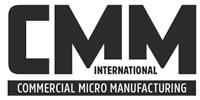
University of California
Merced Relies on
Negative Stiffness Vibration Isolator
from Minus K
Technology
For
accurate research into microscale friction
Case Study |
 | |
Feb.2022 -- Elizabeth Valero, Editor CMM
Magazine: Welcome to the first issue of 2022, which, it goes without
saying, we all hope will be a significantly more positive year than the
previous two. CMM has got off to a good start, with articles expected from new
as well as old faces in the coming months, and I like to think this Is a sign
of our continuance on the road back to normality.
First I thought I
might highlight a case study on how a negative-stiffness vibration isolator
from Minus-K Technology has enabled the School of Engineering at the University
of California Merced (UC Merced) to isolate environmental vibrations and thus
obtain precision microscale or, more specifically, micronewton friction
measurements The school has been using a linear-reciprocating microtribometer
to conduct valuable research into friction and wear on different material
surfaces subjected to various loading and sliding speed conditions. In order to
acquire measurements at (he micron level the microtribometer needs to be
isolated from environmental vibrations, particularly very low hertz vibrations,
these can be due to many factors from equipment and people inside the building
to vehicles and construction noise outside of it.
The negative-stiffness
vibration isolator replaced the vibration isolator the school initially used
for its research but that proved inadequate. This is because the
microtribometer demanded greater vibration Isolation for the measurement of
friction in micronewtons. The ability of the negative-stiffness vibration
isolator 1o achieve a significantly higher level of vibration isolation means
The researchers can be confident that the friction response measured is
attributable to the microtribometer's sliding contact. Moreover, they are able
to study materials that have much lower frictions.
|
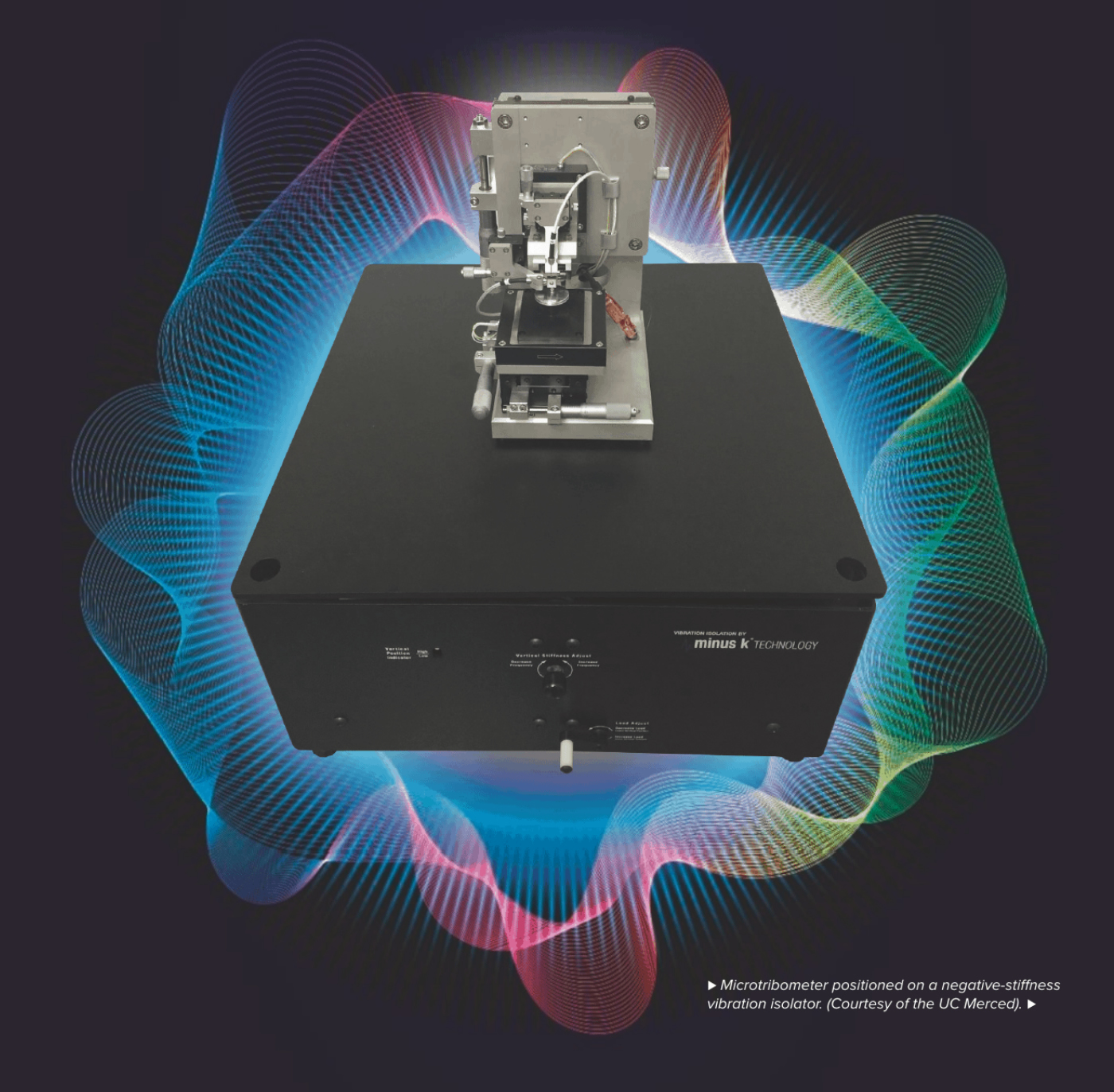
Microtribometer on a Miinus K
Negative Stiffness Vibration Isolator (Courtesy of the UC Merced)
|
The School of Engineering at the University of
California Merced (UC Merced) has been engaged In research focusing on
applications of microscale friction measurements to better understand
fundamental mechanisms underlying tribological phenomena. A critical end
fundamental component of the school's research Is the Isolation of
environmental vibrations utilizing a negative-stiffness vibration isolator from
Minus K Technology which has enabled precision measurements of friction at
micronewton magnitudes.
Whenever two surfaces are moving in contact with
each other their behavior is influenced by friction. Smooth surfaces, even
those polished lo a mirror finish, are not truly smooth on scales. They are
rough, with sharp or rugged projections referred to as
asperities.
Initially, the surfaces only touch at a few of these
asperity points which cover only a very small portion of the surface area.
Friction and wear originate at these points, so understanding their behavior
becomes important when studying materials in contact.
The measurement of
this fractional force between two surfaces is undertaken using a
microtriborneter This instrument measures quantities, such as coefficient of
friction and friction force between the two surfaces that are in contact These
measurements can relate to a number of types of important properties of
mechanical components, including energy efficiency.
The basic operation
of a microtribometer involves a flat of spherical surface that is moved
repetitively across the face of another material. An exact load is applied to
the moving part for the duration of the test. Equipment and methods used to
examine the surfaces before and after sliding include optical microscopes,
scanning electron microscopes, optical interferometers and mechanical roughness
testers. The final measurements show the wear on the material end are often
used to determine its strength and longevity.
The need for vibration
isolation
Microtribometer measurements at the micron level require
isolation from ambient environmental vibrations, particularly very low hertz
vibrations. Isolating a laboratory s sensitive instrumentation against
low-frequency vibrations has become increasingly more vital to maintaining
imaging quality and data Integrity.
|
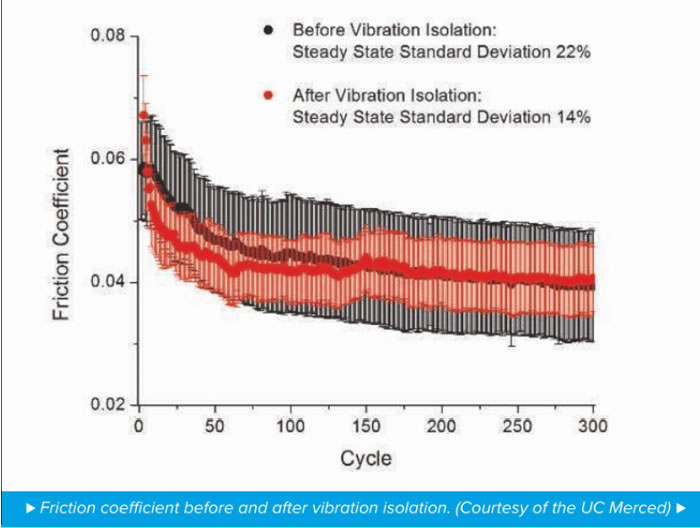
|
|

Negative-Stiffness Vibration
Isolation Aids Quantum Electronic Research
Single-Atom Flakes &
Quantum Electronics Vibration Isolation |
|
Better understanding the character and properties
of graphene, and similar two-dimensional materials, will advance their
integration into improvements for semiconductors, electronics, photovoltaics,
battery energy storage and many other applications.
One university laboratory that has been
conducting research with graphene and other atomically-thin materials for some
years is the Henriksen Research Group at Washington University in St. Louis,
Missouri.
Our experiments entail the careful measurement of the
electronic properties of thinly-layered materials, including both electronic
transport and thermodynamic quantities, such as the magnetization and
compressibility of electron gas, says Professor Erik Henriksen Ph.D., leading
professor of the Henriksen Research Group. We also conduct measurements of the
infrared absorption spectrum to probe the electronic structure directly.
The group searches for unusual and unexpected properties of
low-dimensional materials, utilizing a combination of electronic, optical and
thermodynamic measurement approaches to understand the novel quantum electronic
phases that arise. The experiments are generally conducted at very low
temperatures, fractions of a degree Kelvin above absolute zero, and in high
magnetic fields, employing custom devices made of graphene or related
crystals.
Single-Atom Flakes
We look at the physics of the
layered graphene, where the layers are weakly bound, so they can be pulled
apart, explains Henriksen. We isolate these very thin layers down to a single
atom. Then, lift the graphene flakes from bulk graphite with adhesive tape,
transferring them very carefully onto silicon wafers.
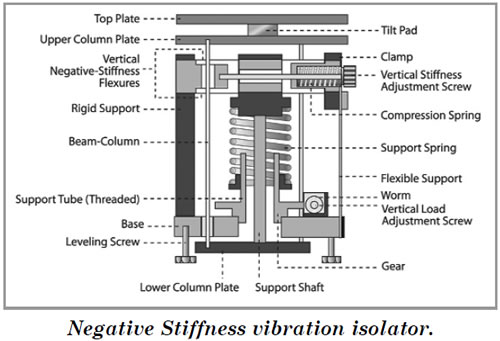
Full article...
|
|
|
In its continuing efforts to revolutionize
discovery-based research into complex biological systems, Pacific Biosciences
has released its next generation of automated, long-read genomic sequencer with
single molecule, real-time (SMRT) sequencing technology – the Sequel
System.
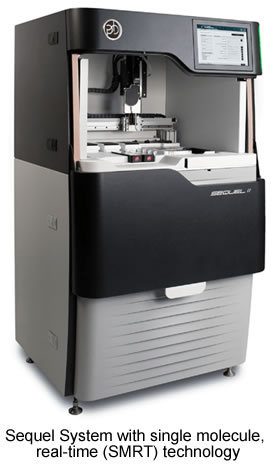
In its continuing efforts to revolutionize
discovery-based research into complex biological systems, Pacific Biosciences
has released its next generation of automated, long-read genomic sequencer with
single molecule, real-time (SMRT) sequencing technology – the Sequel
System.
The Sequel System is very multifaceted in operation, says Kevin
Lin, mechanical engineer at Pacific Biosciences. It encompasses robotics,
chemical and biological processing, and photonics. Because its intended to be
used in diverse settings within research and laboratory environments, excessive
ambient vibrations could negatively influence the data sets. So, we needed to
implement a vibration isolation component that not only isolated the sensitive
components from vibrations, but also was sufficiently small, compact, and
integrative.
Internal and external factors can create vibration issues
from buildings housing the system including heating and ventilation systems,
fans, pumps, elevators, adjacent road traffic, nearby construction, loud noise
from aircraft, and weather conditions. These influences cause vibrations as low
as 2Hz that can create strong disturbances in sensitive equipment.
With
our earlier sequencer model, we used air tables for vibration isolation, which,
for the most part, performed adequately, Lin says. But use of the Sequel System
in more diverse locations, where low-frequency vibrations may be present to a
greater or lesser degree, necessitated a vibration isolator that was compact
enough to fit into our much smaller Sequel System and could effectively cancel
out these low-frequency vibrations.
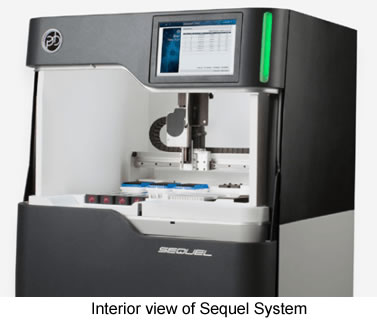
Negative-stiffness vibration
isolation
Pacific Biosciences ultimately decided on negative-stiffness
isolation to address their needs. Developed by Minus K Technology,
negative-stiffness isolators use completely passive mechanical technology for
low-frequency vibration isolation without using motors, pumps, or chambers,
making them zero maintenance. Because of their very high vibration isolation
efficiencies, particularly in the low frequencies, negative-stiffness vibration
isolation systems enable vibration- sensitive instruments, such as the Sequel
System, to operate in severe low-vibration environments that wouldnt be
practical with top-performance air tables and other vibration-mitigation
technologies...
Full article...
|
|
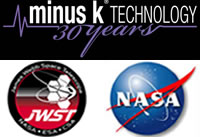
MInus K's Assist with the
Building of the JWST Telescope
|
|
All of the JWST systems-level cryogenic vacuum
tests were performed at the NASA Johnson Space Center’s (JSC) Chamber-A.
It is now the largest high-vacuum, cryogenic-optical test chamber in the
world, and made famous for testing the space capsules for NASA's Apollo
mission, with and without the mission crew. It is 55 feet (16.8 meters) in
diameter by 90 feet (27.4 meters) tall. The door weighs 40 tons and is opened
and closed hydraulically. The air in the chamber weighs 25 tons, when all the
air is removed the mass left inside will be the equivalent of half of a staple.
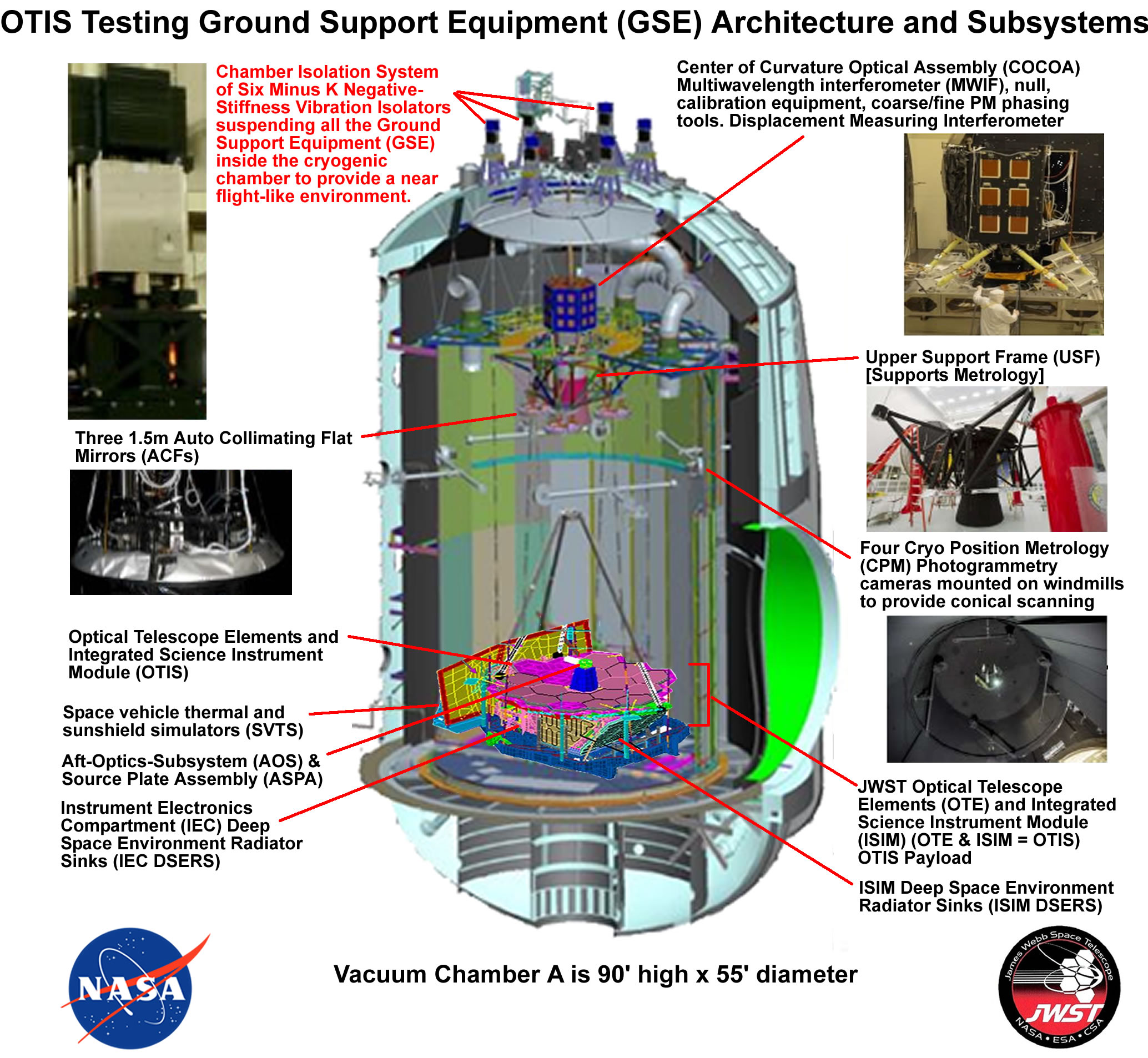
Diagram of the Cyrogenic Chamber in which the JWST
was tested for space.
For three years, NASA JSC engineers built and
remodeled the chambers interior for the temperature needed to test the James
Webb Space Telescope. Chamber A was retrofitted with the helium shroud, inboard
of the existing liquid-nitrogen shroud and is capable of dropping the chambers
temperature farther down than ever, which is 11 degrees above absolute zero (11
Kelvin, -439.9 Fahrenheit or -262.1 Celsius).
A key addition to Chamber
A was the addition of a set of six custom Minus K negative-stiffness
vibration isolators. The Minus K passive isolators do not require air and
offer better isolation than air and active isolation systems. A major factor in
the selection of the of the vibration isolators was that they not only isolate
vibration vertically, but also horizontally at less than 1 Hz.
JWST was
designed to work in space where the disturbances are highly controlled and only
come from the spacecraft, while on Earth with all the ground-based
disturbances, such as the pumps and motors, and even traffic driving by can
affect the testing. The Minus K vibration isolators provided dynamic isolation
from external vibration sources to create a near flight-like disturbance
environment.
The isolators utilize Minus K's patented Thermal
Responsive Element (TRE) compensator device, a passive mechanical device,
requiring no air or electricity just like the isolators. The TRE compensator
adjusted the isolators as the temperature changes throughout the testing at
JSC, keeping the JWST in the proper position.
The Critical Design Review
for Spacecraft-to-Optical Telescope Element vibration isolation system was
completed one month earlier than scheduled at the end of 2011. The six Minus K
negative-stiffness vibration isolators were installed on top of Johnson Space
Centers Thermal Vacuum Chamber A in March 2014.
JWST needed a support
structure inside the vacuum chamber to hold equipment for the testing.
Engineers installed a massive steel platform suspended from the six vibration
isolators via steel rods about 60 feet long (18.2 meters) each and about 1.5
inches (or 38.1 mm) in diameter, to hold the telescope and key pieces of test
equipment. The sophisticated optical telescope test equipment included an
interferometer, auto-collimating flat mirrors, and a system of photogrammetry
precision surveying cameras in precise relative alignment inside the chamber
while isolated from any sources of vibration, such as the flow of nitrogen and
helium inside the shroud plumbing and the rhythmic pulsing of vacuum
pumps.
Minus K's Involvement
continued...
-How much
farther can JWST see than the Hubble?
-Why was
it launched from near the equator?
-How cold
does the JWST get in space?
-How did
origami play into the trip?
-Why
24-karat gold on the mirrors?
Full article...
|
|
Our 29th
Anniversary is on 2/1/22
See the Milestones & Timeline
1993-2022
 | Founded in
1993 |  |
|
|
Minus
K Technology Opens

| |
Minus
K Technology opens for business in
February 1993 |
|
Minus K's original SM-1 patented
Negative-Stiffness passive vibration isolator. This was the first commercialy
available vibration isolator offering 0.5 Hz natural frequencies for both
vertically and horizontally. This was accomplished without the use of air
compressors, computer componets or electricity.
The isolator could be used alone, or in conjunction with other units, and
could be engineered directly into a system. | |
Original
SM-1 Vibration Isolator
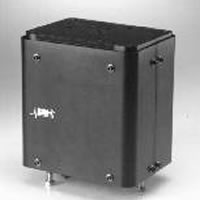 |
Our 29th
Anniversary is on 2/1/22
See the Milestones & Timeline
1993-2022
Press Release:
New Ultra-Thin
CT-2 Low-Frequency
Vibration Isolation Platform Adapts
to Space Constraints in Critical Micro-
and Nano-Microscopy
(replaces the CT-1)
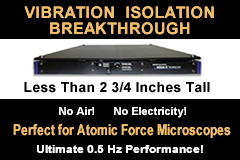

Full
release... |
|
|

 |
|
|
